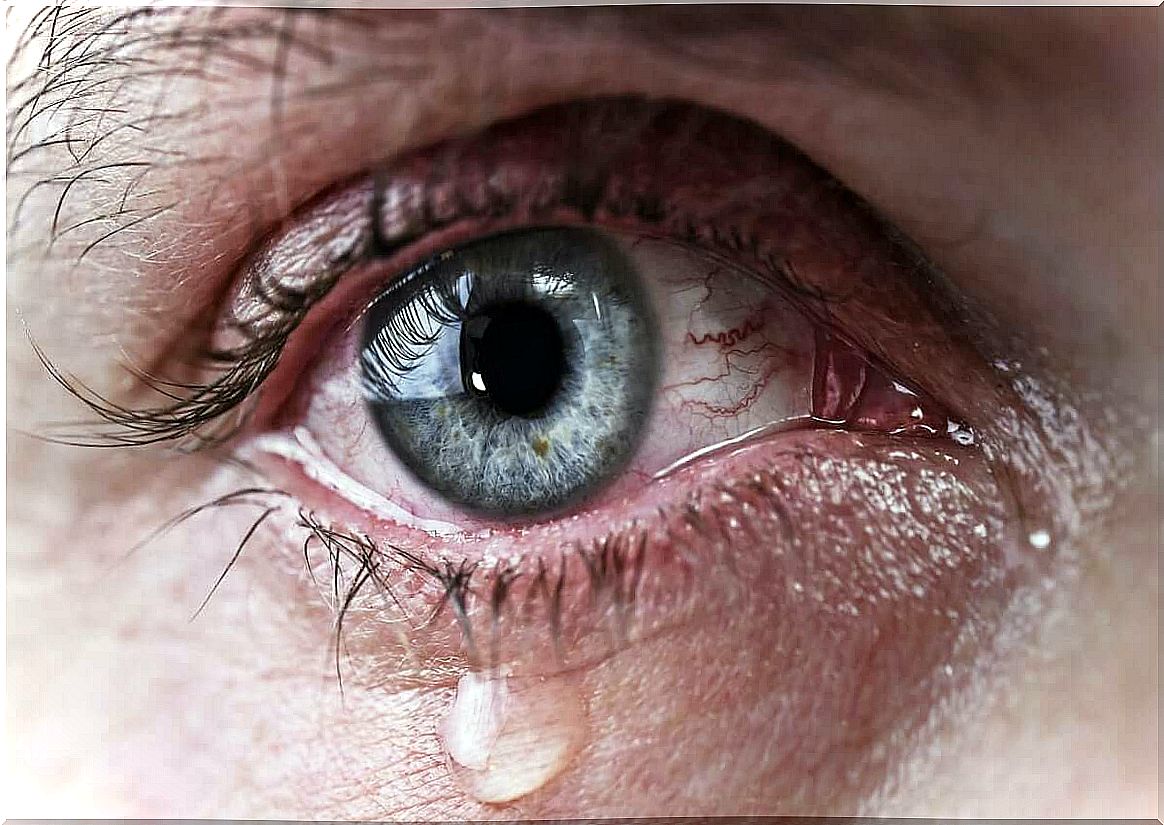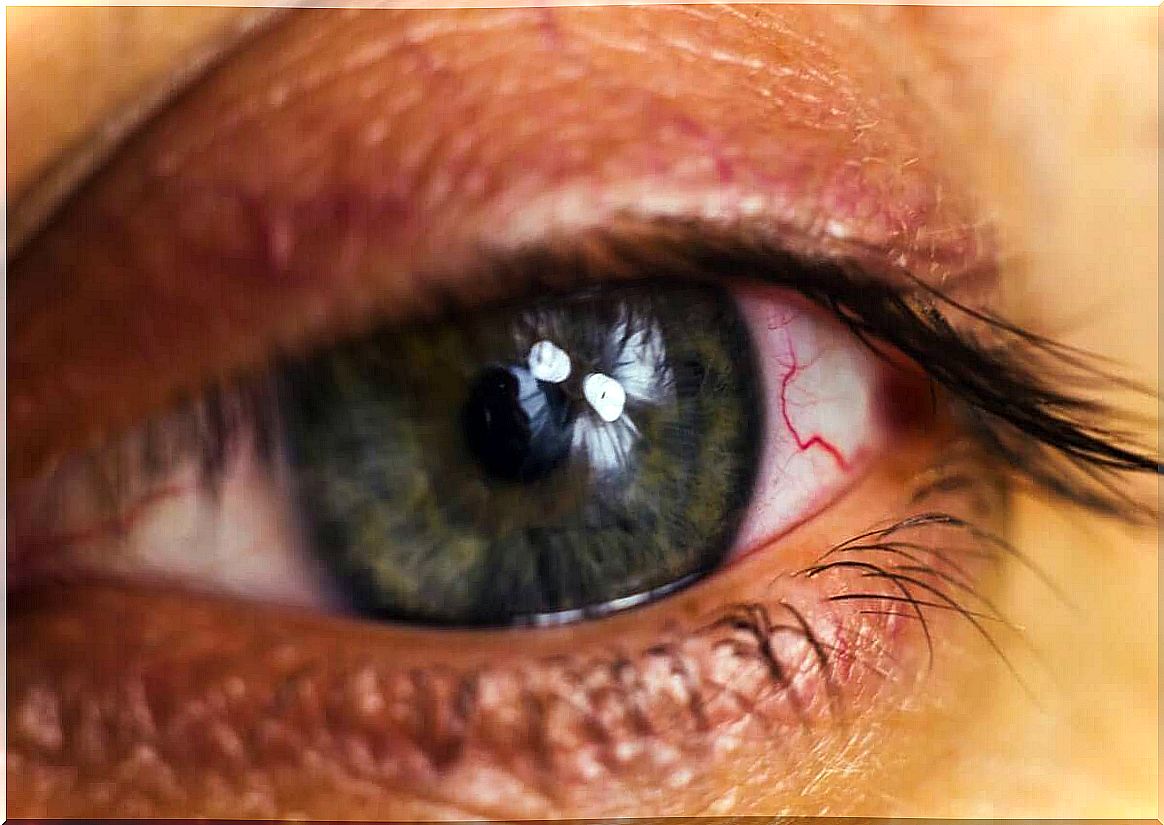What Are The Causes Of Watery Eyes?

In today’s article, we are going to talk about the causes of watery eyes. As the name suggests, watery eyes is about excessive tearing. Believe it or not, it is possible that there is more fluid in this part of the body than is necessary.
We all know that the eye needs lubrication to stay healthy. However, sometimes the fluid that the tear glands produce does not come out. This is due to a blockage of the tear duct leading to the nose, causing fluid to flow over the eyelids.
What are the different types of watery eyes?
We can classify the types of watery eyes based on the affected population. In general, babies and adults are most likely to experience excessive tearing.
Tearing eyes in babies
Although this condition is very common in babies, it is important to be observant to avoid further complications. Often the causes of watery eyes in babies are related to a small blockage of the tear duct or the occurrence of an eye infection.
However, this condition can also occur if your baby has a cold, allergies, or a scratch on his eye. If the tears persist, you should see your pediatrician. He or she will remove any doubts and apply the necessary treatment.
Although less common, this condition can also affect young children. In this case , they can develop corneal abnormalities if, in addition, a reddish discoloration of the eyes is accompanied by the excess of tears.
Tearing eyes in adults

Tears have a protective function in the eye. However, if there are too many tears, they become counterproductive. In the case of adults, the causes of watery eyes are diverse. However, tear duct obstruction remains the most common. There are also other conditions:
- Eye fatigue caused by the overuse of technological devices.
- Extreme dryness of the eye that encourages the formation of tears to compensate.
- Difficulties associated with advanced age.
Causes of watery eyes
The constant tearing caused by this condition is annoying. That’s because it’s usually accompanied by eyelid redness, irritation, swelling, and a burning sensation in the area as well. Nevertheless, it is important to determine the cause in order to start a specific treatment and to rule out further complications.
Obstruction of the tear duct
As we explained at the beginning of the article, lacrimal glands are responsible for producing tears (Spanish link). Their function is to keep the eye clean and lubricated. In the case of excess fluid, it must be drained through the tear duct that ends in the nose.
When this pathway is blocked, tears cannot drain and spill over to the eyelids. This is what happens when our eyes seem to water for no reason.
Specialists know this pathology as chronic dacryocystitis (Spanish link). This can be an acquired condition and refers to the narrowing of the ducts due to aging. There is also a congenital variant that is common in babies.
The dry eye syndrome
Dry eye syndrome has its origins in hormonal changes, in women and also in the high levels of air pollution. Some of the symptoms are:
- A burning sensation.
- Itch.
- photophobia.
- The feeling that the eye is dirty.
- Heaviness of the eyelids.
Another of the most common symptoms, despite the fact that this disease is related to insufficient tears, is a watery eye. This is because the glands are overstimulated as a protective mechanism, causing an excess of fluid.
Tired eyes
This condition, also known as eye fatigue syndrome, falls under the category of occupational diseases. It involves a variety of symptoms, including watery eyes.
It is also associated with the overuse of electronic devices, which is common today with the advent of telecommuting. Cataloged within the digital visual syndromes, this condition can affect the surface of the eye and cause profuse tears.
Conjunctivitis
This is one of the most common eye conditions. It affects people at every stage of life and although it causes quite a bit of discomfort, it is very easy to treat.
Among the most common symptoms of this pathology that affects the conjunctiva (the invisible membrane that covers the eye), we find the watery eye, inflammation, redness and also the secretion or accumulation of rheum.
photophobia
Photophobia is a condition caused by the inability to withstand the intensity of artificial or natural light. It is a pathology that has major consequences for people with albinism and light-colored eyes.
Symptoms include watery eyes, the need to keep the eyes closed, a burning sensation and redness. It can even lead to:
- Dizziness
- Headache
- Nausea and vomiting
Other common and mild causes
In addition to the above conditions, watery eyes have also been linked to allergies, such as rhinitis, as well as flu, laughing, yawning and even vomiting. In each of these cases, the excess of tears is not a problem, as it is due to an external reaction.
When should you consult a professional?

It is important to seek medical attention if you find that the causes of watery eyes are related to an eye infection. This is because it can be viral and contagious. If there is no obvious cause and the discomfort persists for more than a week. This also applies when the symptoms are continuous.
In either case, it is easy to control this eye condition. It is therefore important to seek medical attention to start the corresponding treatment. Excessive tearing is not only an obstacle to quality of life, but it also affects our vision.









